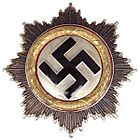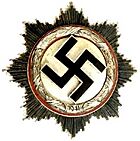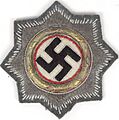German Cross facts for kids
Quick facts for kids German CrossDeutsches Kreuz |
|
|---|---|
 
German Cross in Gold (left) and Silver (right)
|
|
| Presented by | Nazi Germany |
The German Cross (or Deutsches Kreuz in German) was a special military award created by Adolf Hitler on September 28, 1941. It was given during World War II. This award came in two main types: a gold version and a silver version. The gold version was for soldiers who showed great bravery many times or were excellent leaders in battle. The silver version was for people who did important non-combat work to help the war effort.
Contents
What Was the German Cross?
The German Cross was a high-ranking military award. It was given to soldiers who had already earned other important medals. The gold version was considered more important than the Iron Cross First Class. However, it was not as high as the Knight's Cross of the Iron Cross. The silver version was higher than the War Merit Cross First Class with Swords. But it was not as high as the Knight's Cross of the War Merit Cross.
Who Could Receive the Award?
The German Cross had two versions: gold and silver. The color referred to the laurel wreath design on the medal.
- The gold version was for military members. They received it for showing bravery many times in combat. It was usually given after 6 to 8 acts of bravery. It was also for great leadership in battle.
- The silver version was for many important services during the war. These services were not directly in combat. This version was like a higher level of the War Merit Cross with Swords.
If someone received both the silver and gold versions, they were only allowed to wear the gold one.
Requirements for the German Cross
To get the German Cross, a person usually needed to have already received another important medal. This could be the Iron Cross (1939) 1st Class or the War Merit Cross 1st Class with Swords. The German Cross was not a requirement to get the even higher Knight's Cross. In fact, people who already had the Knight's Cross could also receive the German Cross.
While most recipients were military, some people from other uniformed groups could also get it. This included police officers and railway workers. Later in the war, starting in August 1944, soldiers who received the gold class of the Close Combat Clasp often also got the German Cross in gold.
About 25,964 gold crosses and 2,471 silver crosses were awarded in total.
How the German Cross Looked
The German Cross was a star-shaped medal. It had a symbol called a swastika in the middle. The medal was about 6.5 centimeters (about 2.5 inches) wide. Soldiers wore it on the right side of their uniform jacket.
Different Styles of the Award
From June 1942, a cloth version of the gold medal became available. This was easier for soldiers to wear on their combat uniforms. Only the wreath around the swastika was metal on this cloth version. The color of the cloth behind the medal matched the branch of service. For example, the army used field grey, the navy used dark blue, and the air force used pale blue.
There were also 20 special copies made of a "German Cross in Gold with Diamonds." However, this version was never officially given out.
The 1957 Version of the German Cross
After World War II, Germany banned the wearing of Nazi-era awards. This included any display of the swastika symbol. In 1957, the government of West Germany allowed people to wear new versions of some war decorations. These new versions did not have the swastika. For the German Cross, the swastika was replaced. The gold version had a symbol of the Iron Cross. The silver version had a symbol of the War Merit Cross with Swords.
Soldiers in the new German army (the Bundeswehr) could wear a small copy of the de-nazified medal on their uniform ribbon bar.
Notable Recipients
Many soldiers received the German Cross. Here are a few examples of people who received both gold and silver versions:
- Major Josef Gangl (gold, 1945)
- Major General Ernst Merk (gold, 1944; silver, 1942)
- General Felix Schwalbe (gold, 1944; silver, 1943)
- Lieutenant General Bodo Zimmermann (gold, 1944; silver, 1943)
Foreign Recipients of the Gold Cross
In October 1942, the German Cross in Gold could also be given to soldiers from countries allied with Germany. They received it for the same reasons as German soldiers.
Some foreign recipients included:
- Belgium: SS-Standartenführer Léon Degrelle (1944)
- Croatia: Lieutenant Cvitan Galić (1943)
- Finland: General Erik Heinrichs (1943)
- Italy: Vice Admiral Luigi Sansonetti (1942)
- Romania: General Gheorghe Avramescu (1942)
- Spain: Major General Emilio Estéban Infantes y Martín (1943)
In total, about 26 non-German volunteers from various European countries received the German Cross in Gold.
Nicknames for the Award
Some people gave the German Cross nicknames. Colonel Hans von Luck called it "Hitler's fried egg." This was because of its bright and showy design. Another nickname was "The Party Reflector for the Near-Sighted."
Images for kids
-
Award certificate: German Cross in Gold to Count Claus von Stauffenberg 8 May 1943
See also
 In Spanish: Cruz Alemana para niños
In Spanish: Cruz Alemana para niños







